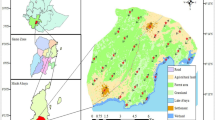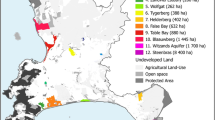Abstract
We studied the habitat of the polecat at different scales in a low density area. For this purpose we gathered data on the presence of the species and characterised them by location, home range and landscape scales. Polecats selected areas of high diversity close to, but not in, streams whilst avoiding intensively managed conifer plantations and dense urban areas. Variables determining the presence/absence of the species were found at home range scales, which implies that management and conservation practices for the species should be aimed mainly at this scale. Finally, our results agree with previously published works, which validate GIS-based approaches as a tool for carnivore management in areas with scarce data or in cases of rare species.
Similar content being viewed by others
References
Baghli A, Engel E, Verhagen R (2002) Feeding habits and trophic niche overlap of two sympatric Mustelidae, the polecat Mustela putorius and the beech marten Martes foina. Z Jagdwiss 48:217–225
Birks J, Kitchener AC (1999) The distribution and status of the polecat (Mustela putorius) in Britain in the 1990’s. Vincent Wildlife Trust, Herefordshire
Blandford PRS (1987) Biology of the polecat Mustela putorius: a literature review. Mammal Rev 17:155–198
Bowman J, Jaeger JAG, Fahrig L (2002) Dispersal distance of mammals is proportional to home range size. Ecology 83:2049–2055
Brzezinski M, Jedrzejewski W, Jedrzejewska B (1992) Winter home ranges and movements of polecats Mustela putorius in Bialowieza primeval forest, Poland. Acta Theriol 37:181–191
Carroll C, Zielinski WJ, Noss RF (1999) Using presence-absence data to build and test spatial habitat models for the fisher in the Klamath region. U S A Conserv Biol 13:1344–1359
Chan-McLeod ACA (2003) Factors affecting the permeability of clearcuts to red-legged frogs. J Wildl Manage 67:663–671
De Marinis AM, Agnelli P (1996) First data on the winter diet of the polecat Mustela putorius (Carnivora, Mustelidae) in Italy. Mammalia 60:144–146
Department of Environment and Land Ordination (2001) Medio Ambiente en la Comunidad Autónoma del País Vasco. Basque Government, Vitoria-Gasteiz
Escala MC, Irurzun JC, Rueda A, Ariño AH (1997) Atlas de los insectívoros y Roedores de Navarra. Análisis biogeográfico. Publicaciones de biología de la Universidad de Navarra, Servicio de Publicaciones de la Universidad de Navarra, Pamplona
Frank LG, Woodroffe R (2001) Behaviour of carnivores in exploited and controlled populations. In: Gittleman JL, Funk SM, Macdonald DW, Wayne RK (eds) Carnivore conservation. Cambridge University Press, Cambridge, pp 419–442
Gehring TM, Swihart RK (2003) Body size, niche breadth, and ecologically scaled responses to habitat fragmentation: mammalian predators in an agricultural landscape. Biol Conserv 109:283–295
Gese EM (2001) Monitoring of terrestrial carnivore populations. In: Gittleman JL, Funk SM, Macdonald DW, Wayne RK (eds) Carnivore conservation. Cambridge University Press, Cambridge, pp 372–396
Gough MC, Rushton SP (2000) The use of GIS in modelling the landscape ecology of mustelids. Mammal Rev 30:197–217
Houlahan JE, Findlay CS (2003) The effects of adjacent land use on wetland amphibian species richness and community composition. Can J Fish Acquat Sci 60:1078–1094
Jedrzejewski W, Jedrzejewska B, Brzezinski M (1993) Winter habitat selection and feeding habits of polecats (Mustela putorius) in the Bialowieza National Park, Poland. Z Säugetierk 58:75–83
Johnson DH (1980) The comparison of usage and availability measurements for evaluating resource preference. Ecology 61:65–71
Jones J (2001) Habitat selection studies in avian ecology: a critical review. Auk 118:557–562
Kenward R (2001) A manual for wildlife radio tagging. Academic, London
Krebs CJ (1989) Ecological methodology. HarperCollins, New York
Lodé T (1993) Diet composition and habitat use of sympatric polecat and American mink in western France. Acta Theriol 38:161–166
Lodé T (1994) Environmental factors influencing habitat exploitation by the polecat Mustela putorius in western France. J Zool Lond 234:75–88
Lodé T (1995) Activity pattern of polecats Mustela putorius L. in relation to food habits and prey activity. Ethology 100:295–308
Lodé T (1996a) Conspecific tolerance and sexual segregation in the use of space and habitats in the European polecat. Acta Theriol 41:171–176
Lodé T (1996b) Polecat predation on frogs and toads at breeding sites in western France. Ethol Ecol Evol 8:115–124
Lodé T (1997) Trophic status and feeding habits of the European polecat Mustela putorius L. 1758. Mammal Rev 27:177–184
Lodé T (1999) Time budget as related to feeding tactics of European polecat Mustela putorius. Behav Proc 47:11–18
Lodé T (2001) Mating system and genetic variance in a polygynous mustelid, the European polecat. Genes Genet Syst 76:221–227
Lodé T (2003) Sexual dimorphism and trophic constraints: prey selection in the European polecat (Mustela putorius). Ecoscience 10:17–23
Lodé T, Pereboom V, Berzins R (2003) Implications of an individualistic lifestyle for species conservation: lessons from jealous beasts. C R Biol 326:S30-S36
Manly FJ, McDonald L, Thomas DL (1993) Resource selection by animals. Chapman & Hall, London
Marnell F (1998) Discriminant analysis of the terrestrial and aquatic habitat determinants of the smooth newt (Triturus vulgaris) and the common frog (Rana temporaria) in Ireland. J Zool Lond 244:1–5
Martínez J A, Serrano D, Zuberogoitia I (2003) Predictive model of habitat preferences for the Eurasian Eagle owl Bubo bubo: a multiscale approach. Ecography 26:21–28
Morrison ML, Marcot BG, Mannan RW (1998) Wildlife-habitat relationships; concepts and applications. The University of Wisconsin Press, Wisconsin
Schadt S, Revilla E, Wiegand T, Knauers F, Kaczensky P, Breitenmoser U, Bufka L, Červený J, Koubek P, Huber T, Staniša C, Trepl L (2002) Assessing the suitability of central European landscapes for the reintroduction of Eurasian lynx. J Appl Ecol 39:189–203
Schröpfer R, Bodenstein C, Seebass C, Recker K, Jordan M (2001) Niche analysis of the Mustela species lutreola, putorius and vison by craniometry and behavioural observations. Säugetierk Inf 25:121–132
Sidorovich V, Jedrzejewska B, Jedrzejewski W (1996) Winter distribution and abundance of mustelids and beavers in the river of Bialowieza Primeval Forest. Acta Theriol 41:155–170
Sidorovich VE, Macdonald DW, Kruuk H, Krasko DA (2000) Behavioural interactions between the naturalized American mink Mustela vison and the native riparian mustelids, NE Belarus, with implications for population changes. Small Carnivore Conserv 22:1–5
Virgos E (2003) Association of the polecat Mustela putorius in eastern Spain with montane pine forests. Oryx 37:484–487
Waldick RC, Freedman B, Wassersug RJ (1999) The consequences for amphibians of the conversion of natural, mixed-species forests to conifer plantations in southern New Brunswick. Can Field Nat 113:408–418
Weber D (1989) The ecological significance of resting sites and the seasonal habitat change in polecats (Mustela putorius). J Zool Lond 217:629–638
Wilson GJ, Delahay RJ (2001) A review of methods to estimate the abundance of terrestrial carnivores using signs and field observations. Wildl Res 28:151–164
Zar J H (1999) Biostatistical analysis. Prentice Hall, Upper Saddle River
Zuberogoitia I (2002) Ecoetología de las rapaces nocturnas en Bizkaia. PhD Thesis, UPV-EHU, Leioa
Zuberogoitia I, Torres JJ, Zabala J, Campos MA (2001) Carnívoros de Bizkaia. BBK, Bilbao
Acknowledgements
The authors wish to express their gratitude to the Department of Environment and Land Ordination of the Basque Government for providing digital cartography, to the Bizkaia Wildlife Rescue Centre and the regional wildlife keepers for providing information on trapped animals and road kill, and to E. Virgós, Prof. T. Lodé and one anonymous reviewer for useful comments on previous drafts.
Author information
Authors and Affiliations
Corresponding author
Rights and permissions
About this article
Cite this article
Zabala, J., Zuberogoitia, I. & Martínez-Climent, J.A. Site and landscape features ruling the habitat use and occupancy of the polecat (Mustela putorius) in a low density area: a multiscale approach. Eur J Wildl Res 51, 157–162 (2005). https://doi.org/10.1007/s10344-005-0094-z
Received:
Accepted:
Published:
Issue Date:
DOI: https://doi.org/10.1007/s10344-005-0094-z




